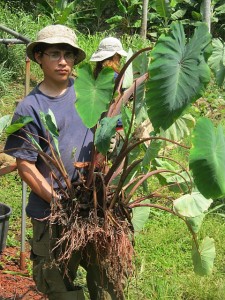Recently the Ohana has been hard at work harvesting Taro in the garden and creating new ways to spice up an ancient plant. Taro, also known as “kalo,” is one of the original “canoe plants” that the Polynesians brought to Hawaii to propagate and sustain a new civilization. An interesting fact that students at Pacific Quest wilderness therapy program learn during their stay here is that the Hawaiians understood the meaning of family or “Ohana” by observing and cultivating the nutritious kalo plant. Kalo wasn’t only used to feed a new civilization, but it also served a deeper purpose to teach the functions and sacrifices  that are universally experienced within the family or ohana. During the activity of harvesting the kalo, students learn the meaning of “oha,” which describes the individual buds that sprout from ‘the parent’ kalo plant. The parent plant provides a massive tuber, which is taken to the kitchen for cooking, while the ohas are separated and replanted in the garden in order to grow into mature plants. At Pacific Quest wilderness program, the understanding of Ohana is the backbone of our community, and can be learned experientially through the simple task of growing this sacred plant.
that are universally experienced within the family or ohana. During the activity of harvesting the kalo, students learn the meaning of “oha,” which describes the individual buds that sprout from ‘the parent’ kalo plant. The parent plant provides a massive tuber, which is taken to the kitchen for cooking, while the ohas are separated and replanted in the garden in order to grow into mature plants. At Pacific Quest wilderness program, the understanding of Ohana is the backbone of our community, and can be learned experientially through the simple task of growing this sacred plant.
The Taro Harvest Festival would not be complete without a true feast with an opportunity for the students to put a modern twist on an ancient recipe. Taro can be eaten in a variety of ways, in Hawaii most commonly as poi, which is a thick purple paste- anybody hungry? With a little creativity the students transformed this less appetizing food into something that could make its way on a cooking show. To its credit, taro is a very nutritious mineral rich carbohydrate that is alkalizing for the body and easy to digest. Ancient Hawaiians often used taro as the first food for infants because it’s so nutritious and gentle on the stomach. The students at Pacific Quest  have been resourceful when it comes to creating new ways to use the harvested taro. As an alternative to poi, the students decided to make a “Taro Spinach” dip. They boiled the taro leaves as an alternative to spinach and then mixed them in with the mashed root, coconut milk, onion, garlic and Parmesan cheese… add a dash of Hawaiian sea salt to taste! The last step involved wrapping the mixture in a sacred Ti leaf and steaming it for four hours. Don’t forget the thinly sliced taro chips lightly fried to a crisp in organic coconut oil. The end result was a festival that not only provided a feast that was good for the body, but also a lesson on family and Hawaiian history.
have been resourceful when it comes to creating new ways to use the harvested taro. As an alternative to poi, the students decided to make a “Taro Spinach” dip. They boiled the taro leaves as an alternative to spinach and then mixed them in with the mashed root, coconut milk, onion, garlic and Parmesan cheese… add a dash of Hawaiian sea salt to taste! The last step involved wrapping the mixture in a sacred Ti leaf and steaming it for four hours. Don’t forget the thinly sliced taro chips lightly fried to a crisp in organic coconut oil. The end result was a festival that not only provided a feast that was good for the body, but also a lesson on family and Hawaiian history.